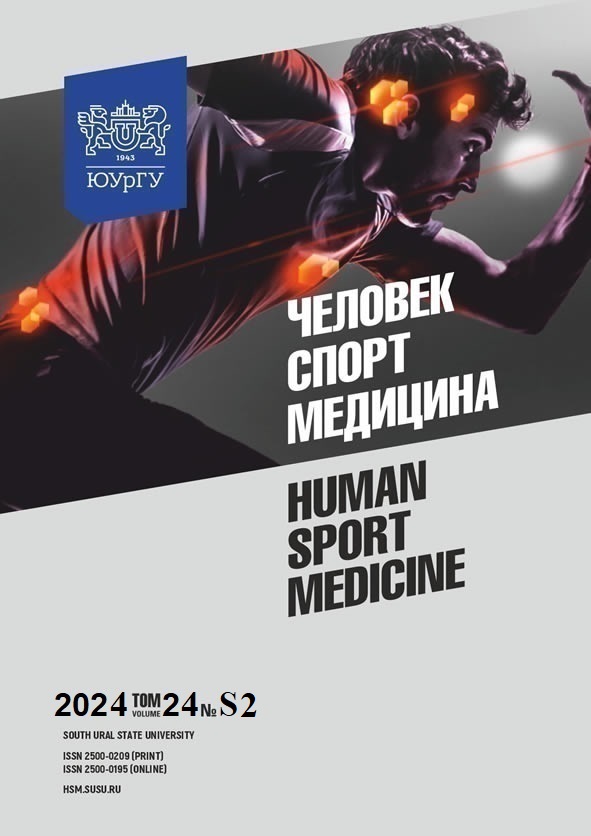VARIABILITY OF VERTICAL GROUND REACTION FORCES IN PERSONS WITH DIFFERENT DEGREES OF LOWER LIMB IMPAIRMENT
Abstract
Aim. This study aims to identify patterns in sensory data to determine descriptors of dynamic balance during walking in individuals with varying degrees of lower limb function impairment. Materials and methods. Data acquisition was performed using the Xsens MTw Awinda motion capture system and Xsens MVN Analyze software. Our analysis focused on assessing the variability of vertical ground reaction forces in lower limb segments, comparing values between adjacent segments (paired Student’s t-test), and examining relationships between adjacent segments’ reactions (foot-pelvis; Pearson’s r) in three subjects with a history of lower limb injuries of varying severity. Results. Data from MIMU sensors provided as sensory networks (body segments: pelvis, hips, shins, and feet) allow for accurate assessment of acceleration (vertical ground reaction) of each segment in individuals with varying severity of neuromuscular lower limb impairment. These characteristics serve as descriptors of neuromuscular interaction of adjacent lower limb segments, reflecting gait asymmetry in subjects. Conclusion. The identified descriptors (variability, consistency, interconnection) are of utmost importance for the development of anthropomorphic prostheses, habilitation and prosthetic rehabilitation protocols, and neural network classifiers for lower limb neuromuscular disorders.
References
2. Curtze C., Hof A.L., Postema K., Otten B. Over Rough and Smooth: Amputee Gait on an Irregular Surface. Gait and Posture, 2011, vol. 33, pp. 292–296. DOI: 10.1016/j.gaitpost.2010.11.023
3. De Asha A.R., Buckley J.G. The Effects of Laterality on Obstacle Crossing Performance in Unilateral Transtibial Amputees. Clinical Biomechanics (Bristol, Avon), 2015, vol. 30(4), pp. 343–346. DOI: 10.1016/j.clinbiomech.2015.03.001
4. Demeco A., Frizziero A., Nuresi C. et al. Gait Alteration in Individual with Limb Loss: The Role of Inertial Sensors. Sensors (Basel), 2023, vol. 23 (4), art. 1880. DOI: 10.3390/s23041880
5. Fey N.P., Klute G.K., Neptune R.R. The Influence of Energy Storage and Return Foot Stiffness on Walking Mechanics and Muscle Activity in Below-knee Amputees. Clinical Biomechanics (Bristol, Avon), 2011, vol. 26 (10), pp. 1025–1032. DOI: 10.1016/j.clinbiomech.2011.06.007
6. Kamali M., Karimi M.T., Eshraghi A., Omar H. Influential Factors in Stability of Lower-limb Amputees. American Journal of Physical Medicine and Rehabilitation, 2013, vol. 92 (12), pp. 1110–1118. DOI: 10.1097/PHM.0b013e31829b4b7a
7. Lemaire E.D., Kofman J., Kendell C. Understanding Dynamic Stability from Pelvis Accelerometer Data and the Relationship to Balance and Mobility in Transtibial Amputees. Gait and Posture, 2015, vol. 41, iss. 3, pp. 808–812. DOI: 10.1016/j.gaitpost.2015.03.001
8. Lordall J., Oates A.R., Lanovaz J.L. Spatiotemporal Walking Performance in Different Settings: Effects of Walking Speed and Sex. Frontiers in Sports and Active Living, 2024, vol. 6, art. 1277587. DOI: 10.3389/fspor.2024.1277587
9. Pavei G., Salis F., Cereatti A., Bergamini E. Body Center of Mass Trajectory and Mechanical Energy Using Inertial Sensors: a Feasible Stride? Gait and Posture, 2020, vol. 80, pp. 199–205. DOI: 10.1016/j.gaitpost.2020.04.012
10. Pitkin M. The Moment Criterion of Anthropomorphicity of Prosthetic Feet as a Potential Predictor of Their Functionality for Transtibial Amputees. Biomimetics, 2023, vol. 8 (8), art. 572. DOI: 10.3390/biomimetics8080572
11. Schepers M., Giuberti M., Bellusci G. Xsens MVN: Consistent Tracking of Human Motion Using Inertial Sensing. 2018. DOI: 10.13140/RG.2.2.22099.07205
12. Simonetti E., Bergamini E., Vannozzi G. et al. Estimation of 3D Body Center of Mass Acceleration and Instantaneous Velocity from a Wearable Inertial Sensor Network in Transfemoral Amputee Gait: a Case Study. Sensors, 2021, vol. 21(9), art. 3129. DOI: 10.3390/s21093129
References on translit
1. Эрлих В.В., Епишев В.В., Сапожников С.Б. Биомеханика ходьбы в норме и при наличии протеза ноги с использованием комплекса Xsens // Человек. Спорт. Медицина. 2023. Т. 23, № 4. С. 145–154. [Erlikh V.V., Epishev V.V., Sapozhnikov S.B. Gait Biomechanics in Normal Conditions and with a Lower-extremity Prosthesis Captured by the Xsens System. Human. Sport. Medicine, 2023, vol. 23 (4), pp. 145–154. (in Russ.)] DOI: 10.14529/hsm2304182. Curtze C., Hof A.L., Postema K., Otten B. Over Rough and Smooth: Amputee Gait on an Irregular Surface. Gait and Posture, 2011, vol. 33, pp. 292–296. DOI: 10.1016/j.gaitpost.2010.11.023
3. De Asha A.R., Buckley J.G. The Effects of Laterality on Obstacle Crossing Performance in Unilateral Transtibial Amputees. Clinical Biomechanics (Bristol, Avon), 2015, vol. 30(4), pp. 343–346. DOI: 10.1016/j.clinbiomech.2015.03.001
4. Demeco A., Frizziero A., Nuresi C. et al. Gait Alteration in Individual with Limb Loss: The Role of Inertial Sensors. Sensors (Basel), 2023, vol. 23 (4), art. 1880. DOI: 10.3390/s23041880
5. Fey N.P., Klute G.K., Neptune R.R. The Influence of Energy Storage and Return Foot Stiffness on Walking Mechanics and Muscle Activity in Below-knee Amputees. Clinical Biomechanics (Bristol, Avon), 2011, vol. 26 (10), pp. 1025–1032. DOI: 10.1016/j.clinbiomech.2011.06.007
6. Kamali M., Karimi M.T., Eshraghi A., Omar H. Influential Factors in Stability of Lower-limb Amputees. American Journal of Physical Medicine and Rehabilitation, 2013, vol. 92 (12), pp. 1110–1118. DOI: 10.1097/PHM.0b013e31829b4b7a
7. Lemaire E.D., Kofman J., Kendell C. Understanding Dynamic Stability from Pelvis Accelerometer Data and the Relationship to Balance and Mobility in Transtibial Amputees. Gait and Posture, 2015, vol. 41, iss. 3, pp. 808–812. DOI: 10.1016/j.gaitpost.2015.03.001
8. Lordall J., Oates A.R., Lanovaz J.L. Spatiotemporal Walking Performance in Different Settings: Effects of Walking Speed and Sex. Frontiers in Sports and Active Living, 2024, vol. 6, art. 1277587. DOI: 10.3389/fspor.2024.1277587
9. Pavei G., Salis F., Cereatti A., Bergamini E. Body Center of Mass Trajectory and Mechanical Energy Using Inertial Sensors: a Feasible Stride? Gait and Posture, 2020, vol. 80, pp. 199–205. DOI: 10.1016/j.gaitpost.2020.04.012
10. Pitkin M. The Moment Criterion of Anthropomorphicity of Prosthetic Feet as a Potential Predictor of Their Functionality for Transtibial Amputees. Biomimetics, 2023, vol. 8 (8), art. 572. DOI: 10.3390/biomimetics8080572
11. Schepers M., Giuberti M., Bellusci G. Xsens MVN: Consistent Tracking of Human Motion Using Inertial Sensing. 2018. DOI: 10.13140/RG.2.2.22099.07205
12. Simonetti E., Bergamini E., Vannozzi G. et al. Estimation of 3D Body Center of Mass Acceleration and Instantaneous Velocity from a Wearable Inertial Sensor Network in Transfemoral Amputee Gait: a Case Study. Sensors, 2021, vol. 21(9), art. 3129. DOI: 10.3390/s21093129
Copyright (c) 2025 Human. Sport. Medicine

This work is licensed under a Creative Commons Attribution-NonCommercial-NoDerivatives 4.0 International License.















